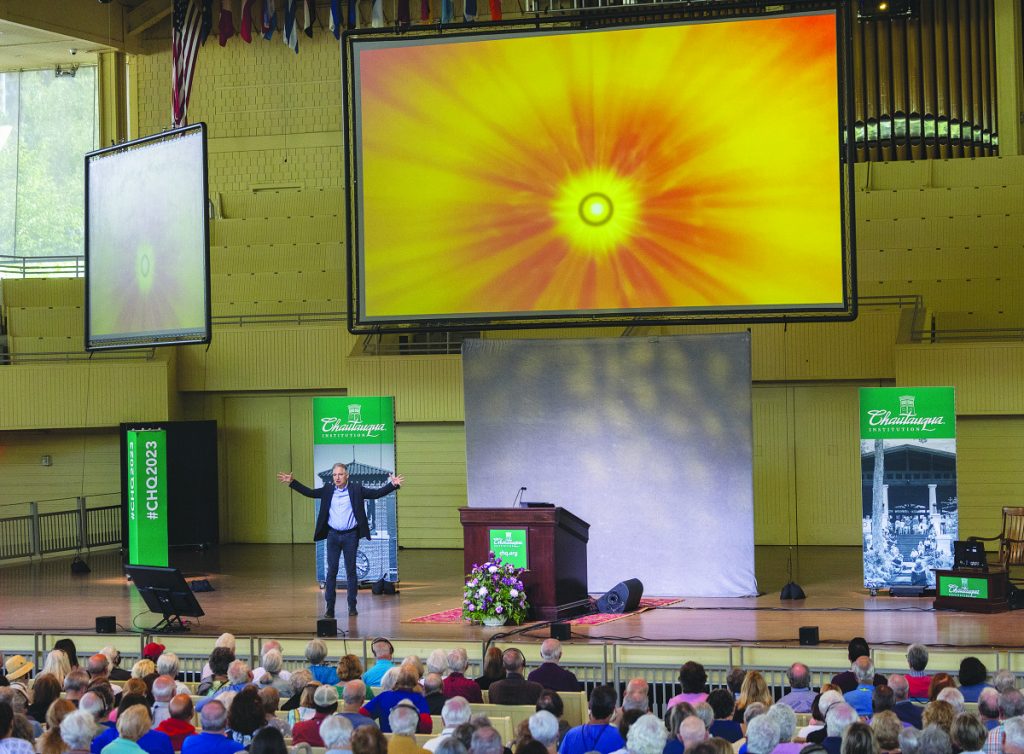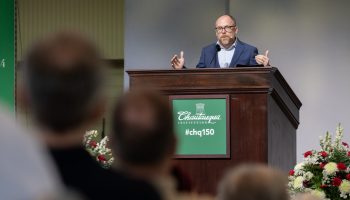ALTON NORTHUP
STAFF WRITER

Humanity’s reluctance to challenge preconceived beliefs nearly thwarted some of the most important scientific discoveries.
“We operate through a combination of the rational and the emotional,” said Brian Greene. “This, in many ways, is what makes us human beings. Where we get into trouble is when we conflate these two distinct but interrelated ways of grasping the world.”
Greene, a professor of physics and mathematics at Columbia University, and director of Columbia’s Center for Theoretical Physics, discussed the scientific role of disbelief and belief at 10:45 a.m. Wednesday in the Amphitheater, continuing the Chautauqua Lecture Series Week Four theme, “The State of Believing.”
In the late 1600s, Isaac Newton famously created a universal law of gravity: Every particle attracts every other particle in the universe with a force that is proportional to the product of their masses and inversely proportional to the square of the distance between their centers. With this law, and its accompanying formula, one could even describe how the planets move.
Except, Newton had left something out. He never explained how the force of gravity actually works. Centuries later, a young Albert Einstein set himself the task of filling this gap, Greene said.
By the 20th century, New- ton’s law of universal gravitation was so entrenched in scientific understanding of the natural world that Max Planck, Einstein’s mentor, told him no one would believe him if he proved Newton wrong.
After 10 years, Einstein succeeded in doing just that with his general relativity theory. The theory states the curvature of spacetime is directly related to the energy and momentum of whatever matter and radiation are present.
“If you’ve got the Earth, and you’ve got the sun, and there’s empty space between them, it’s gotta be space it- self, empty space itself, that must be the medium, the mechanism, by which gravity istransmittedfromplaceto place,” Greene said.
Einstein’s theory can best be analogized with a rub- ber sheet, a marble and a bowling ball. If the marble is rolled on the surface of the stretchedsheet,itwillmove in a straight trajectory. How- ever, if the bowling ball is added, the marble’s path will now be a curved trajectory.
“Einstein says, take that idea, replace the rubber sheet by space, replace the large object … by the sun,” Greene said. “The sun, merely by vir- tue of its presence in space, warps the environment. The earth, like the marble, will go into orbit because it’s rolling along this curved surface of space itself.”
With this theory, Einstein contributed an unexpected idea to physics that few paid attention to; after all, New- ton’s law was law. However, Einstein’s theory would be proved correct in 1919 when the Eddington experiment measured the gravitation- al deflection of starlight during a solar eclipse and compared it to Einstein’s predictions in 1915.
When asked what he would have done if his the- ory was proved wrong, Ein- stein replied, “I would have felt sorry for the dear Lord. The theory is correct.”
He had changed the way science understood gravity, but it almost did not happen, Greene said. In 1911, Einstein had a different equation that he was not able test, with the outbreak of World War I just a few years later. This delay favored Einstein, who noticed his initial equation was wrong. Despite this, he hesitated to fix the math be- cause his equations “were too beautiful to be wrong.”
Einstein’s refusal to change his error was not based on data, but on inner intuition, Greene said.
“The problem with inner intuitions is sometimes they will lead you in the right direction, (and) sometimes they will lead you in the wrong direction,” he said.
Realizing the math was more important than his feelings, Einstein eventually fixed the equation in time for the 1919 experiment, Greene said. The same cannot be said for the reaction of some in the scientific community to his proven theory.
Swedish engineer Arvid Reuterdahl considered the theory of relativity to be nonsense and attempted to disparage Einstein’s integrity through accusations of plagiarism. German physicist Philipp Lenard called Einstein’s theory harmful to science and publicly defended “Aryan science.” Henry Ford’s newspaper, The Dearborn Independent, painted his discovery as a Jewish conspiracy.
Despite the pushback and blatant anti-semitism, the general theory of relativity is nowtheaccepteddescription of gravity in modern physics.
“The beauty of science is if you wait long enough, truth wins out,” Greene said. “Belief ultimately does fit into the so-called scientific method, but the process to get through the journey is much more human. It’s much more messy.”
Einstein was not immune to this messy process, either. In 1916, German physicist Karl Schwarzchild was the first to find a solution to his general relativity equations almost immediately after their release.
Through the equation, Schwarzchild also found that if a spherical mass is squeezed small enough, there is such an incredible warp in the fabric of space that anything that gets too close, even light itself, wouldbeunabletoescape. He discovered, in modern terms, the existence of black holes.
“When Einstein caught wind of this, he completely resisted the idea,” Greene said.
Greene suspected Ein- stein was agitated because someone else had solved his equations before him. Even worse, Schwarzchild re- vealed the equation broke down when accounting for the center of a black hole.
The math, Einstein concluded, was contrary to his belief system. But without the data to support this resistance, other scientists soon recognized the mechanism that allows black holes to form.
“Imagine you have a large, red, giant star,” Greene said. “It supports its incredible mass through nuclear processes in the core, but sooner or later, the star uses up its nuclear fuel. And when it does, it can’t support its own weight, so the star begins to implode inward.”
The star gets hotter and denser until an explosion results, rippling through the star until it reaches the surface. What remains is a core with no capacity to support its own weight, inexorably collapsing into a black hole. For the Earth to become a black hole, it would need to be squeezed down to two centimeters across, Greene said.
In 2019, the Event Horizon Telescope photographed a supermassive black hole at the center of the galaxy Messier 87 – the first photograph of its kind. In 2022, the project photographed a supermassive black hole at the center of the Milky Way.
“Einstein’s intuition, in this case, was wrong,” Greene said. “His belief that they couldn’t exist was wrong. They do exist.”
Still, Einstein was no stranger to being on the other side of belief. Between 1916 and 1918, he proposed the possibility of what is now called gravitational waves.
This concept can be illustrated by a running child sending ripples through a trampoline, Greene said. Because the fabric of space warps and curves, astronomical bodies also send ripples as they move.
Einstein was skeptical of this theory, even after fix- ing his equation and getting the same results. Gravitational waves were simply an artifact of mathematical analysis, and the math was so subtle he could not appreciate what it meant.
Upon impact, the waves stress and compress anything they contact. Because the stretching measures less than an atomic diameter, gravitational waves were not detected until 2015. Working backward, researchers discovered that the waves they detected came from two black holes that collided 1.3 billion lightyears away.
With these discoveries out of the way, Greene said, one big question still remains: How did the universe begin?
The prevailing theory is the Big Bang, proposed by Georges Lemaître, which states everything emerged from a primordial atom.
A Catholic priest with the unusual distinction of holding a Ph.D. in physics from the Massachusetts Institute of Technology, Lemaître studied Einstein’s equations in 1927 and con- cluded that the universe, contrary to his belief, is not static;itiseitherstretch- ing or collapsing.
In 1917, Einstein also noticed this but, finding the idea repugnant, changed the equations to avoid the possibility of a dynamic cosmos.
“If space is expand- ing, then way back when it would all be together it suggests that maybe there’s a creation event,” Greene said. “For Einstein, it felt too theological; it felt too religious.”
In response to Lemaître, Einstein decried his inability to know which math was relevant to physics. Prior to this, Russian physicist Alexander Friedmann had contacted Einstein regarding similar findings in 1922, which Einstein publicly disparaged. He would eventually retract these comments after Edwin Hubble provided observational evidence in 1929 for the universe be- ing a finite age.
In a time when science seems more controversial than ever, Greene said he wanted to remind Chautauquans that what is now accepted as common fact also faced opposition.
“The vagaries – the messiness of getting to truth – ultimately settles down,” he said.




